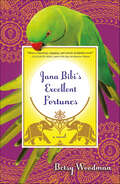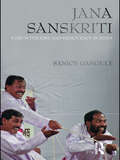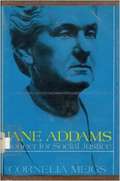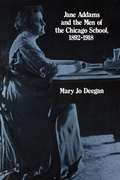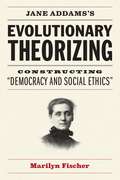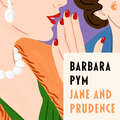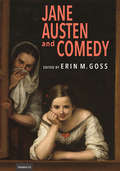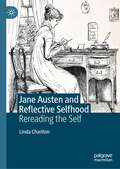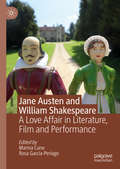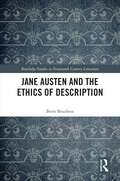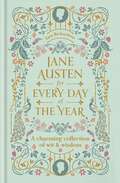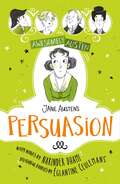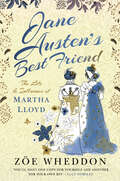- Table View
- List View
Jana Bibi's Excellent Fortunes: A Novel (Jana Bibi Adventures #1)
by Betsy WoodmanMeet Jana Bibi, a Scottish woman helping to save the small town in India she has grown to call home and the oddball characters she considers familyJanet Laird's life changed the day she inherited her grandfather's house in a faraway Indian hill station. Ignoring her son's arguments to come grow old in their family castle in Scotland, she moves with her chatty parrot, Mr. Ganguly and her loyal housekeeper, Mary, to Hamara Nagar, where local merchants are philosophers, the chief of police is a tyrant, and a bagpipe-playing Gurkha keeps the wild monkeys at bay. Settling in, Jana Bibi (as she comes to be known) meets her colorful local neighbors—Feroze Ali Khan of Royal Tailors, who struggles with his business and family, V.K. Ramachandran, whose Treasure Emporium is bursting at the seams with objects of unknown provenance, and Rambir, editor of the local newspaper, who burns the midnight oil at his printing press. When word gets out that the town is in danger of being drowned by a government dam, Jana is enlisted to help put it on the map. Hoping to attract tourists with promises of good things to come, she stacks her deck of cards, readies her fine-feathered assistant—and Jana Bibi's Excellent Fortunes is born.
Jana Sanskriti: Forum Theatre and Democracy in India
by Sanjoy GangulyJana Sanskriti Centre for the Theatre of the Oppressed, based in West Bengal, is probably the largest and longest lasting Forum Theatre operation in the world. It was considered by Augusto Boal to be the chief exponent of his methodology outside of its native Brazil. This book is a unique first-hand account - by the group's artistic director Sanjoy Ganguly - of Jana Sanskriti's growth and development since its founding in 1985, which has resulted in a national Forum Theatre network throughout India. Ganguly describes the plays, people and places that have formed this unique operation and discusses its contribution to the wider themes espoused by Forum Theatre. Ganguly charts and reflects on the practice of theatre as politics, developing an intriguing and persuasive case for Forum Theatre and its role in provoking responsible action. His combination of anecdotal insight and lucid discussion of Boal’s practice offers a vision of far-reaching transformation in politics and civil society.
Janamsakhis: Ageless Stories, Timeless Values
by Harish DhillonJanamsakhis, as the name suggests, are stories that claim to reveal the life of the first Guru, Nanak Dev, in a chronological manner. The earliest known Janamsakhi dates back to 1658, nearly 120 years after the death of Guru Nanak in 1539. None of the Janamsakhis can claim to be the most authentic or authoritative version as, through the years, each chronicler of the Guru’s life has added and altered the narrative according to the need of the times. In this volume, Dr Harish Dhillon has chosen the twenty most inspiring and interesting stories about the life and times of Guru Nanak. While the language may be contemporary, at its core this narrative has the same venerable feel that marked the tone of Janamsakhis written centuries ago. Through this work, the author has tried to make the life of the Guru more accessible to the current generation. This book enlightens as much as it informs, while focussing on the Guru’s teachings as well as the various udasis (travels) he undertook to spread the message of brotherhood, equality and love. This book will be of immense value to anyone with a particular interest in religious studies, Indian history or in simply learning more about the life of Guru Nanak.
Jane Addams Pioneer of Social Justice
by Cornelia MeigsJane Addams, the first women to receive the Nobel Peace prize, was a vivid example of the influence that can be achieved through courage, perseverance, personal integrity and respect for others regardless of social status. Not only is this book an interesting historical narrative, but it carefully reminds the reader of unsuitable urban living and working conditions of the past as it traces the development of social attitudes now taken for granted.<P><P> Jane Addams Children’s Book Award Winner
Jane Addams and the House That Helped [Approaching Level, Grade 1]
by Barbara KanninenNIMAC-sourced textbook
Jane Addams and the House That Helped [Beyond Level, Grade 1]
by Barbara KanninenNIMAC-sourced textbook
Jane Addams and the House That Helped [On Level, Grade 1]
by Barbara KanninenNIMAC-sourced textbook
Jane Addams and the Men of the Chicago School, 1892-1918
by Mary Jo DeeganJane Addams is well known for her leadership in urban reform, social settlements, pacifism, social work, and women’s suffrage.The men of the Chicago School are well known for their leadership in founding sociology and the study of urban life.What has remained hidden however, is that Jane Addams played a pivotal role in the development of sociology and worked closely with the male faculty at the Department of Sociology at the University of Chicago.
Jane Addams's Evolutionary Theorizing: Constructing “Democracy and Social Ethics”
by Marilyn FischerIn Jane Addams’s Evolutionary Theorizing, Marilyn Fischer advances the bold and original claim that Addams’s reasoning in her first book, Democracy and Social Ethics, is thoroughly evolutionary. While Democracy and Social Ethics, a foundational text of classical American pragmatism, is praised for advancing a sensitive and sophisticated method of ethical deliberation, Fischer is the first to explore its intellectual roots. Examining essays Addams wrote in the 1890s and showing how they were revised for Democracy and Social Ethics, Fischer draws from philosophy, history, literature, rhetoric, and more to uncover the array of social evolutionary thought Addams engaged with in her texts—from British socialist writings on the evolution of democracy to British and German anthropological accounts of the evolution of morality. By excavating Addams’s evolutionary reasoning and rhetorical strategies, Fischer reveals the depth, subtlety, and richness of Addams’s thought.
Jane And Prudence (Virago Modern Classics #312)
by Barbara PymBY THE NEW YORK TIMES BESTSELLING AUTHOR INTRODUCED BY JILLY COOPER'I'm a huge fan of Barbara Pym' RICHARD OSMAN'I devoured all her books, but Jane and Prudence remains my favourite' JILLY COOPER 'Barbara Pym is the rarest of treasures; she reminds us of the heartbreaking silliness of everyday life' ANNE TYLERIf Jane Cleveland and Prudence Bates seem an unlikely pair to be walking together at an Oxford reunion, neither of them is aware of it. They couldn't be more different: Jane is a rather incompetent vicar's wife, who always looks as if she is about to feed the chickens, while Prudence, a pristine hothouse flower, has the most unsuitable affairs. With the move to a rural parish, Jane is determined to find her friend the perfect man. She learns, though, that matchmaking has as many pitfalls as housewifery.'This comedy of manners is a salutary reminder of just how good Barbara Pym was . . . This book is a gem' THE TIMES
Jane Austen (LIVES #6)
by Carol ShieldsBestselling, award-winning novelist writing about one of the most popular and enduring English novelists of all time.'Splendid ... a gem' LITERARY REVIEW'An excellent biography' MAIL ON SUNDAY'Shields on Austen offers up a delicious prospect. And we are not disappointed' SCOTSMANJane Austen was one of the world's most remarkable writers, whose characters are as alive today as they were two hundred years ago. Despite being one of the most perceptive writers about people and relationships, she never married and always lived with her parents and sister Cassandra.Perhaps unusual for women at that time, Jane Austen was acutely aware of the larger political and social world around her, but chose to focus her novels on the family as a microcosm through which to explore human nature.The prizewinning novelist Carol Shields gives us a beautifully written, perceptive look at the life of one of the finest and most popular English novelists of all time.
Jane Austen and Comedy (Transits: Literature, Thought & Culture 1650-1850)
by Erin GossJane Austen and Comedy takes for granted two related notions. First, Jane Austen’s books are funny; they induce laughter, and that laughter is worth attending to for a variety of reasons. Second, Jane Austen’s books are comedies, understandable both through the generic form that ends in marriage after the potential hilarity of romantic adversity and through a more general promise of wish fulfillment. In bringing together Austen and comedy, which are both often dismissed as superfluous or irrelevant to a contemporary world, this collection of essays directs attention to the ways we laugh, the ways that Austen may make us do so, and the ways that our laughter is conditioned by the form in which Austen writes: comedy. Jane Austen and Comedy invites reflection not only on her inclusion of laughter and humor, the comic, jokes, wit, and all the other topics that can so readily be grouped under the broad umbrella that is comedy, but also on the idea or form of comedy itself, and on the way that this form may govern our thinking about many things outside the realm of Austen’s work. Published by Bucknell University Press. Distributed worldwide by Rutgers University Press.
Jane Austen and Reflective Selfhood: Rereading the Self
by Linda CharltonThis book makes connections between selfhood, reading practice and moral judgment which propose fresh insights into Austen’s narrative style and offer new ways of reading her work. It grounds her writing in the Enlightenment philosophy of selfhood, exploring how Austen takes five major components of selfhood theory—memory, imagination, probability, sympathy and reflection—and investigates their relation to self-formation and moral judgement. At the same time, Austen’s narrative style breaks new ground in the representation of consciousness and engages directly with contemporary concerns about reading practice. Drawing analogies between reading text and reading character, the book argues that Austen’s rendering of reading and rereading as both reflective and constitutive acts demonstrates their capacity to enable self-recognition and self-formation. It shows how Austen raises questions about the potential for different readings and, in so doing, challenges her readers to reflect on and reread their own interactions with her texts.
Jane Austen and Sciences of the Mind (Routledge Studies in Romanticism)
by Beth LauThe essays in this volume interpret Jane Austen’s fiction through the lens of various sciences of the mind and brain, especially the cluster of disciplines implicated in the term cognitive science, including neuroscience, evolutionary biology, evolutionary and developmental psychology, and others. The field of cognitive literary studies has rapidly developed in the last few decades and achieved the status of an established (if still evolving) critical approach. One of the most popular authors to analyze from this perspective is Jane Austen. As numerous critics have noted, Austen was a keen observer of how the mind operates in its interactions with other minds, both when it functions successfully and when, as often happens, it goes awry, and her perceptions are often in synch with current neuroscientific and psychological research. Despite the widespread recognition of the special congruity between Austen’s novels and cognitive science, however, no book has been devoted to this subject. Jane Austen and Sciences of the Mind is the first monograph wholly comprised of readings of Austen’s oeuvre (juvenilia as well as all six completed novels) from cognitive and related psychological approaches. In addition, the volume operates under the assumption that cognitive and historicist approaches are compatible, and many essays situate Austen within the climate of ideas during her era as well as in relation to current research in the sciences and social sciences. Jane Austen and Sciences of the Mind offers a new lens for understanding and illuminating the concerns, techniques, and enduring appeal of Austen’s novels.
Jane Austen and William Shakespeare: A Love Affair in Literature, Film and Performance
by Marina Cano Rosa García-PeriagoThis volume explores the multiple connections between the two most canonical authors in English, Jane Austen and William Shakespeare. The collection reflects on the historical, literary, critical and filmic links between the authors and their fates. Considering the implications of the popular cult of Austen and Shakespeare, the essays are interdisciplinary and comparative: ranging from Austen’s and Shakespeare’s biographies to their presence in the modern vampire saga Twilight, passing by Shakespearean echoes in Austen’s novels and the authors’ afterlives on the improv stage, in wartime cinema, modern biopics and crime fiction. The volume concludes with an account of the Exhibition “Will & Jane” at the Folger Shakespeare Library, which literally brought the two authors together in the autumn of 2016. Collectively, the essays mark and celebrate what we have called the long-standing “love affair” between William Shakespeare and Jane Austen—over 200 years and counting.
Jane Austen and the Ethics of Description (Routledge Studies in Nineteenth Century Literature)
by Brett BourbonJane Austen and the Ethics of Description demonstrates that Elizabeth Bennet and her creator are misunderstood, and often unrecognized, geniuses of moral philosophy, but not simply because of their virtue or wit or natural skills in game theory. The engine driving the moral judgement and growth of Austen’s protagonists consists of a particular and not well-understood ability to reason by description, a skill which we moderns must recover and remaster in order to negotiate the complexities of contemporary life. The forms of rational description this volume derives from Austen will be of great interest to not only literary critics and theorists, but also to philosophers and anyone interested in ethics, the dynamics of power, and practical reasoning. Written in a clear style, the book is for those who love Austen and for those who want to understand how we should reason about our lives. The book is written for those who love Austen, of course, but also for those who are interested in questions about how to live and in fundamental and practical questions about power, social conflict, self-awareness, and practical reasoning. It is a literary analysis, a philosophical argument, and a practical guide to ethical thinking.
Jane Austen at Home: A Biography
by Lucy Worsley'This is my kind of history: carefully researched but so vivid that you are convinced Lucy Worsley was actually there at the party - or the parsonage.' Antonia Fraser'A refreshingly unique perspective on Austen and her work and a beautifully nuanced exploration of gender, creativity, and domesticity.' Amanda ForemanOn the 200th anniversary of Jane Austen's death, historian Lucy Worsley leads us into the world in which our best-loved novelist lived. This new telling of the story of Jane's life shows us how and why she lived as she did, examining the rooms, spaces and possessions which mattered to her, and the way in which home is used in her novels to mean both a place of pleasure and a prison. It wasn't all country houses and ballrooms, in fact her life was often a painful struggle.Jane famously lived a 'life without incident', but with new research and insights Lucy Worsley reveals a passionate woman who fought for her freedom. A woman who far from being a lonely spinster in fact had at least five marriage prospects, but who in the end refused to settle for anything less than Mr Darcy.(P)2017 Hodder & Stoughton Limited
Jane Austen at Home: A Biography
by Lucy WorsleyTHE SUNDAY TIMES BESTSELLER'This is my kind of history: carefully researched but so vivid that you are convinced Lucy Worsley was actually there at the party - or the parsonage.' Antonia Fraser'A refreshingly unique perspective on Austen and her work and a beautifully nuanced exploration of gender, creativity, and domesticity.' Amanda ForemanLucy Worsley 'is a great scene-setter for this tale of triumph and heartbreak.' Sunday TimesOn the 200th anniversary of Jane Austen's death, historian Lucy Worsley leads us into the rooms from which our best-loved novelist quietly changed the world.This new telling of the story of Jane's life shows us how and why she lived as she did, examining the places and spaces that mattered to her. It wasn't all country houses and ballrooms, but a life that was often a painful struggle. Jane famously lived a 'life without incident', but with new research and insights Lucy Worsley reveals a passionate woman who fought for her freedom. A woman who far from being a lonely spinster in fact had at least five marriage prospects, but who in the end refused to settle for anything less than Mr Darcy.
Jane Austen at Home: A Biography (250th Birthday Edition)
by Lucy WorsleyTo celebrate the 250th anniversary of Jane Austen's birth, Lucy Worsley has written a new Introduction to her Sunday Times Bestselling biography - the book that leads us into the rooms from which our best-loved novelist quietly changed the world.This telling of the story of Jane's life shows us how and why she lived as she did, examining the places and spaces that mattered to her. It wasn't all country houses and ballrooms, but a life that was often a painful struggle. Jane famously lived a 'life without incident', but with new research and insights Lucy Worsley reveals a passionate woman who fought for her freedom. A woman who far from being a lonely spinster in fact had at least five marriage prospects, but who in the end refused to settle for anything less than Mr Darcy.
Jane Austen for Every Day of the Year
by Tara RichardsonJane Austen for Every Day of the Year is a charming collection of 366 quotes and short passages drawn from Jane Austen's novels, with excerpts from her intimate, witty letters scattered throughout. This book is perfect for reading or sharing and brings you passages from Jane Austen's best-loved classics alongside the lesser-known works. Packed full of witty remarks and wry observations, this is the perfect companion to inspire laughter and spark delightful conversation - a gift to treasure all year long.Some of the most-loved quoted lines include:'It is a truth universally acknowledged, that a single man in possession of a good fortune, must be in want of a wife.' Pride and Prejudice'There is no charm equal to tenderness of heart.' Emma'Know your own happiness. You want nothing but patience - or give it a more fascinating name, call it hope.' Sense and SensibilityJane Austen, celebrated for her keen observations of social manners and romantic entanglements, is best known for classics such as Pride and Prejudice, Sense and Sensibility and Emma. Next year marks the 250th anniversary of Jane Austen's birth, and this celebratory collection - with beautiful vintage line illustrations - is the perfect gift for every Austen fan.
Jane Austen for Every Day of the Year
by Tara RichardsonJane Austen for Every Day of the Year is a charming collection of 366 quotes and short passages drawn from Jane Austen's novels, with excerpts from her intimate, witty letters scattered throughout. This book is perfect for reading or sharing and brings you passages from Jane Austen's best-loved classics alongside the lesser-known works. Packed full of witty remarks and wry observations, this is the perfect companion to inspire laughter and spark delightful conversation - a gift to treasure all year long.Some of the most-loved quoted lines include:'It is a truth universally acknowledged, that a single man in possession of a good fortune, must be in want of a wife.' Pride and Prejudice'There is no charm equal to tenderness of heart.' Emma'Know your own happiness. You want nothing but patience - or give it a more fascinating name, call it hope.' Sense and SensibilityJane Austen, celebrated for her keen observations of social manners and romantic entanglements, is best known for classics such as Pride and Prejudice, Sense and Sensibility and Emma. Next year marks the 250th anniversary of Jane Austen's birth, and this celebratory collection - with beautiful vintage line illustrations - is the perfect gift for every Austen fan.
Jane Austen's Persuasion (Awesomely Austen - Illustrated and Retold #13)
by Jane Austen Narinder DhamiA fresh, funny and accessible retelling of Jane Austen's classic story.When she was just 19, Anne Elliot followed the wishes of her father and turned down the proposal of the man she loved - a naval officer called Frederick Wentworth. Years later, Captain Wentworth returns from his time at sea, and Anne dares to hope that their paths might cross once more. But the course of true love is bumpy at best - will Anne and Frederick ever be reunited?Narinder Dhami is the author of The Sleepover Club and The Beautiful Game series. Jane Austen is her favourite author of all time and she can't wait to introduce a new audience to Austen's final novel. Églantine Ceulemans captures all of Austen's satire and wit, bringing her colourful casts to life with warm and funny black and white illustrations.Illustrated and retold editions are also available for: Pride and Prejudice, Persuasion, Sense and Sensibility, Mansfield Park and Northanger Abbey. The perfect way to discover Austen for the first time, this bright and bold collection features some of the most inspiring and famous heroines in English literature. For readers aged eight and up.
Jane Austen's Persuasion (Awesomely Austen - Illustrated and Retold #3)
by Jane Austen Narinder DhamiA fresh, funny and accessible retelling of Jane Austen's classic story, with witty black and white illustrations throughout.When she was just nineteen, Anne Elliot followed the wishes of her father and turned down the proposal of the man she loved - a naval officer called Frederick Wentworth. Years later, Captain Wentworth returns from his time at sea, and Anne dares to hope that their paths might cross once more. But the course of true love is bumpy at best - will Anne and Frederick ever be reunited?Narinder Dhami is the author of The Sleepover Club and The Beautiful Game series. Jane Austen is her favourite author of all time and she can't wait to introduce a new audience to Austen's final novel. Églantine Ceulemans captures all of Austen's satire and wit, bringing her colourful casts to life with warm and funny black and white illustrations.Illustrated and retold editions are also available for: Pride and Prejudice, Persuasion, Sense and Sensibility, Mansfield Park and Northanger Abbey. The perfect way to discover Austen for the first time, this bright and bold collection features some of the most inspiring and famous heroines in English literature. For readers aged eight and up.
Jane Austen's Persuasion (Awesomely Austen - Illustrated and Retold #3)
by Jane Austen Narinder DhamiA fresh, funny and accessible retelling of Jane Austen's classic story, with witty black and white illustrations throughout.When she was just nineteen, Anne Elliot followed the wishes of her father and turned down the proposal of the man she loved - a naval officer called Frederick Wentworth. Years later, Captain Wentworth returns from his time at sea, and Anne dares to hope that their paths might cross once more. But the course of true love is bumpy at best - will Anne and Frederick ever be reunited?Narinder Dhami is the author of The Sleepover Club and The Beautiful Game series. Jane Austen is her favourite author of all time and she can't wait to introduce a new audience to Austen's final novel. Églantine Ceulemans captures all of Austen's satire and wit, bringing her colourful casts to life with warm and funny black and white illustrations.Illustrated and retold editions are also available for: Pride and Prejudice, Persuasion, Sense and Sensibility, Mansfield Park and Northanger Abbey. The perfect way to discover Austen for the first time, this bright and bold collection features some of the most inspiring and famous heroines in English literature. For readers aged eight and up.
Jane Austen's Best Friend: The Life and Influence of Martha Lloyd
by Zöe WheddonThe story of Martha Lloyd—recipe collector, housekeeping expert, and Jane Austen&’s dearest friend. Fans of Jane Austen often feel that the beloved author is like a best friend—and this book shines a light on what it meant to be exactly that. Jane Austen&’s Best Friend: The Life and Influence of Martha Lloyd offers a unique insight into Jane&’s private inner circle. Through this heartwarming examination of an important and often overlooked person in Jane&’s world, we uncover the life-changing force of their friendship. Each chapter details the fascinating facts and friendship-forming qualities that tied Jane and Martha together. Within these pages we relive their shared interests, the hits and misses of their romantic lives, their passion for shopping and fashion, their family histories, their lucky breaks, and their girly chats. This book offers a behind-the-scenes tour of the shared lives of a fascinating pair and the chance to deepen our own bonds in &“love and friendship&” with them both.
